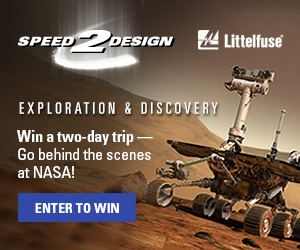Water recycled with no machinery? A “hyperwall” able to visualize the birth of the solar system? That and more will be shared with the 10 lucky engineers who are chosen as winners in first round of the Littelfuse Speed2Design sweepstakes.

As part of this year’s Speed2Design Program, engineers can enter to win a two-day trip to go behind the scenes at NASA Ames Research Center in Moffett Field, California on August 15, 2013. There’s no cost to participate. The winners will see some of NASA’s most exciting and sophisticated technology anywhere among the space agency’s 10 field centers. Enter to win at www.speed2design.com.
Last year, Speed2Design took engineers behind the scenes at several IndyCar race events to learn the inner workings of a hi-tech race car team, from the garage to the pits, through qualifying and race day. This year, the Littelfuse commitment to continuing the Speed2Design program extends to the advanced technologies being developed at NASA for space exploration and the betterment of life here on Earth.
The two-day trip to NASA Ames Research Center is part of the Speed2Design Exploration & Discovery , a program sponsored by Littelfuse, which provides a unique technology-packed experience specifically for the design engineering community. Winners will be randomly selected to participate in a two-day trip to NASA Ames Research Center or Johnson Space Center (Houston, Texas), where winners will meet face-to-face with NASA engineers involved in creating the most sophisticated technology in the world.
“The winners will go where few have gone before,” explains Rhonda Stratton, Marketing Communications Manager. “This is not simply a tour of the public facilities. It’s a once-in-a-lifetime experience to explore behind the scenes what is being developed at NASA and to meet the innovative and creative people behind these new technologies in a series of peer-to-peer TechTalk discussions. Our winners will be awe-struck by everything NASA’s technology exchange has to share.”
Here is a preview of what the lucky winners will experience at the NASA Ames Research Center:
• Forward Osmosis Lab – is it possible to create potable water with a system that uses no power, no moving parts and has 100% reliability? NASA engineers will reveal how they’ve done it.
• Hyperwall – supercomputing environment that combines a wall of 128 monitors with processing power equal to 600 game consoles for advanced modeling and simulation.
• 80 x 120 Wind Tunnel – what’s it like to stand inside the largest wind tunnel in the world?
• Future Flight Control – how do NASA engineers lay out airports of the future? We’ll even see how they simulate “air traffic control” on Mars.
• Nano-Satellite Design – can you create a satellite for $8000 using off-the-shelf parts? NASA did and will show us how.
• Prognostics Lab – watch NASA’s advanced algorithms handle “uncertainty management” in predicting component health and “physics of failure” to ensure leading space and aerospace technology performs at the very highest levels of reliability.
The prize package for each two-day trip to either NASA Ames Research Center (Moffett Field, CA, Aug. 14-15th) or NASA Johnson Space Center (Houston, TX, Oct. 23-24th) will include a tour of the NASA center and peer-to-peer TechTalks with NASA engineers in their labs. Additionally, there is a cocktail reception the night before the event, lunch and dinner the day of the event, two-night hotel accommodations, ground transportation between the hotel and event and a $500 debit card to use for travel expenses and other incidentals.
Enter to win Speed2Design at www.speed2design.com. Entry deadline is July 24th.
About Littelfuse
Founded in 1927, Littelfuse is the world leader in circuit protection with growing global platforms in power control and sensing. The company serves global customers in the electronics, automotive and industrial markets with technologies including fuses, semiconductors, polymers, ceramics, relays and sensors. Littelfuse has over 7,000 employees in more than 35 locations throughout the Americas, Europe and Asia. For more information, please visit the Littelfuse website: littelfuse.com.
About Speed2Design
The Littelfuse Speed2Design program provides support and solutions for time-pressured electronic engineers around the world who are seeking answers and information about proper circuit protection technology, selection and best practices in design. The Speed2Design “rapid-response center” website provides design-related content that includes tutorials, selector guides, design kits, webcasts, sample circuits and FAQs. Interactive elements enable engineers to share their experiences or consult with others to solve their design problems including a Q&A forum, blogs and live chat.
About NASA Technology Exchange
The NASA Ames Technology Partnerships Division facilitates transfer of NASA Ames Research Center technologies and capabilities into NASA's Mission Directorates, Programs, and Projects through investments and partnerships with industry, academia, government agencies, and national laboratories. These activities increase NASA's connection to emerging technologies in external communities and make NASA's technology portfolio available to industry and academia to support NASA's strategic goals. Technology transfer through dual-use partnerships and licensing also creates many important socio-economic benefits within the broader community.
The Technology Transfer and Commercialization Office (TTO) at NASA’s Johnson Space Center (JSC) facilitates the transfer and commercialization of NASA-sponsored research and technology as well as the use of JSC’s unique research and development capabilities and facilities. The office works with entrepreneurs, companies, and investors, helping them license NASA-developed technologies so they can bring them to the marketplace. The office also works to develop partnerships with companies, universities, other federal agencies, and national labs that will leverage the partner’s expertise and facilities as well as JSC’s. Partnerships enable JSC to leverage technology being developed externally and infuse it into NASA programs.
Advertisement





